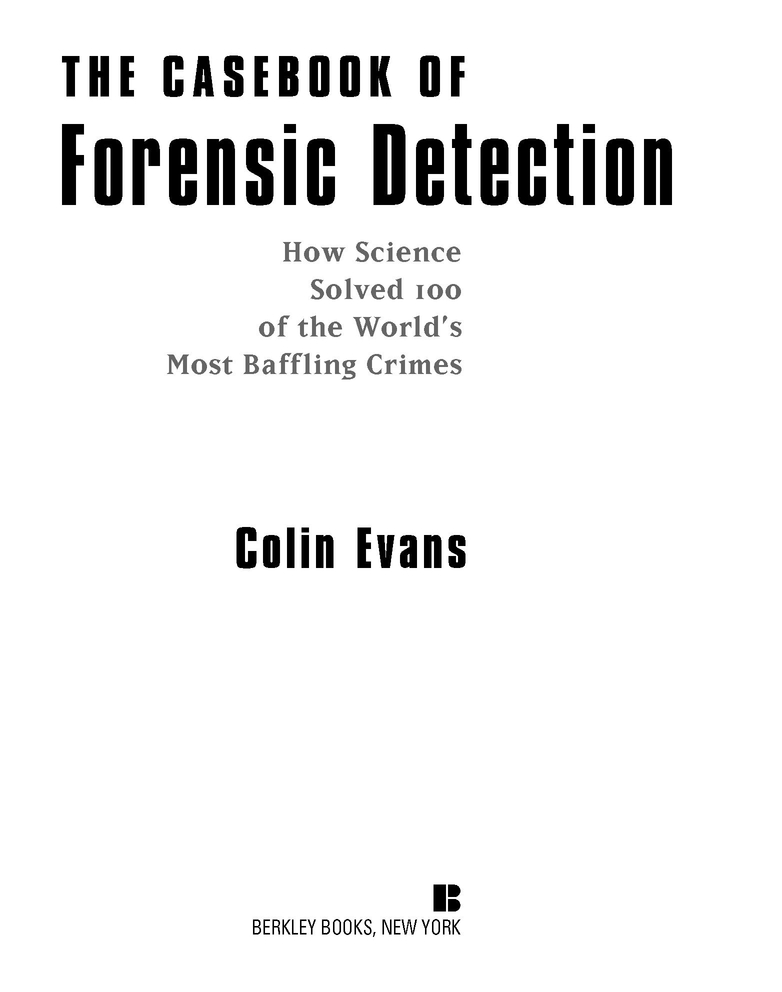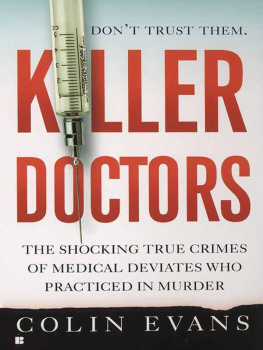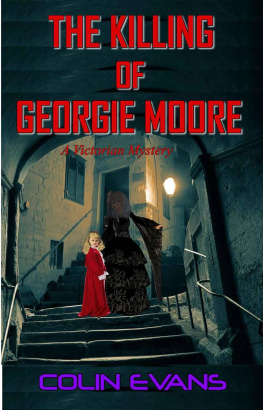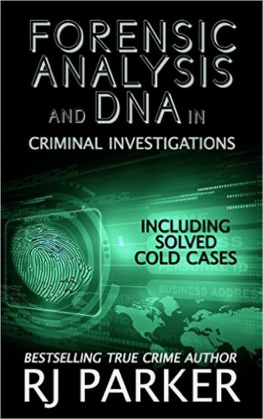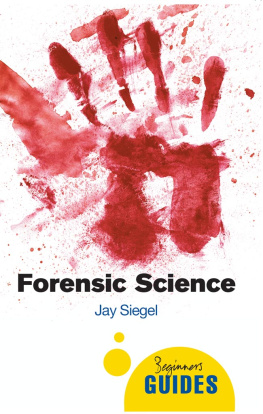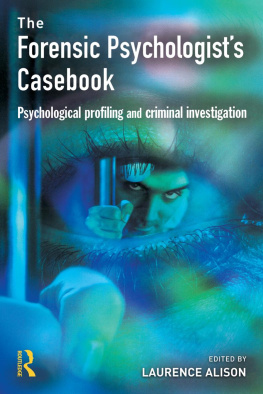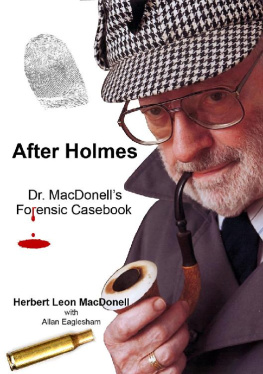Table of Contents
Praise for The Casebook of Forensic Detection
This well-organized compendium covers cases... arranged according to the methodology by which they were solved.... ranging from ballistics through DNA typing, fingerprinting, odontology, serology, and toxicology.... even the most dedicated devotee of the genre will find much that is new in these exciting accounts of the brilliant and persistent scientific work that brought murderers like John List, Ted Bundy, and Jeffrey MacDonald to justice. Publishers Weekly
Contains ample material to hold the attention and foster interest in science. Science Teacher
A mystery novelists essential resource guide. Book News, Inc.
Pithy, concise, and remarkably accurate. Science Books & Films
Some of the cases covered:Computerized fingerprint analysis stops one of Californias worst killersthe Nightstalker.
Forensic sculpture reconstructs a face from a skull and catches the man in the clowns suitJohn Wayne Gacy.
Computer-enhanced imagery helps capture one of Americas Most WantedJohn List.
Crime solving changes foreverpsychological profiling and New York Citys Mad Bomber.
DNA typing and one of twentieth centurys great mysterieswas Anna Anderson the real Anastasia, the daughter of Czar Nicholas II, and the last of the Romanovs?
How forensic experts identified a victim with only one one-thousandth of her body parts.
A psychological profile that helped catch a dangerous criminal who drank his victims blood.
What bones reveal about the victimand the perpetrator.
Computer enhancement catches a killer eighteen years after the crime.
Most Berkley Books are available at special quantity discounts for bulk purchases for sales promotions, premiums, fund-raising, or educational use. Special books, or book excerpts, can also be created to fit specific needs.
For details, write: Special Markets, The Berkley Publishing Group, 375 Hudson Street, New York, New York 10014.
Freed this ones for you.
Acknowledgments
In any book of this kind the role of the writer is but a contributory part; most of the credit is due to the selfless support I received on both sides of the Atlantic. Among the individuals who gave so graciously of their time and effort are William H. Garvie, FBI; Brad Smith, Los Angeles DAs office; Amy Louise Kazmin, Los Angeles Times; Wayne T. Seay, Chief of Detectives, Nassau County Police Department; Tina Vicini, Chicago Police Department; and Gerard J. Sciaraffa, Circuit Court of Cook County, Illinois.
Research staff at the New York Public Library, the National Archives, the Library of Congress, the Broward County Library in Florida, and the British Newspaper Library at Colindale, London, all provided unstinting and selfless assistance.
As always, David Andersen shared his encyclopedic knowledge of crime and his enviable book collection. Both are greatly appreciated. Greg Manning, too, helped ease the burden. Samantha Mandor at Berkley Publishing has been unfailingly supportive. Thanks also to Mary Ray Worley at Impressions Book and Journal Services, whose meticulous copyediting helped clarify so much in the manuscript. I owe a special debt of gratitude to my agent, Ed Knappman, who first suggested this volume and who offered many constructive ideas in its shaping. Needless to say, while all of these people contributed so much to this book, responsibility for any errors is mine alone. Finally, a very special thank-you to Norma, without whom none of this would have happened.
INTRODUCTION
If history decides to remember the twentieth century as the century of science, then it will also record that a sizable portion of that science was devoted to catching criminals. Although rudimentary attempts at scientific detection date from the mid-1700s, only in the past one hundred years has crime fighting been put on a truly systematic footing. The results have been remarkableenough to astound even Sherlock Holmes, the fictional forerunner of todays technosleuth. But whereas Sir Arthur Conan Doyles creation combed crime scenes with a magnifying glass, his modern counterparts employ ultraviolet light, lasers, DNA, spectrographs, neutron activation analysis, computer software, scanning electron microscopes, blood grouping, and any number of other tools to identify that which we cant see and analyze that which we can.
The Casebook of Forensic Detection is an attempt to chart the progress of scientific detection through concise and accurate summaries of one hundred criminal cases from around the globe, all of which played their part in establishing the role of science in modern crime fighting. Selection has largely been dictated by a desire to inform and entertain and will be of use to both the casual reader and the serious researcher. Although some cases have become medicolegal classics, others are barely known. But of one thing you can be sure: None is ordinary. Each has some facet, some twist, that elevates it from the pack. Inevitably, space constraints have made it necessary to exclude many deserving cases. I hope the reader will agree that all of those chosen fully merit their place, and if your own particular favorite should happen to be absent, then please accept my apology. A bias toward American and European cases is unavoidable, because both regions have figured so prominently in the forensic crusade. But nonetheless, the major contributions of Australasia and South America have not been overlooked.
For ease of reference, the various topics, such as Ballistics, DNA Typing, Fingerprinting, and Trace Evidence, are listed in alphabetical order. Then, the individual cases within each category are arranged chronologically. In this way, a clear picture of how each specialty has evolved can be formed.
Populating these stories, beyond the victims and villains, are the forensic pioneers. Some were brilliant, carving landmarks in the annals of forensic medicine; others advanced opinions with an arrogance that only experience would subdue. For the most part, early juries regarded them all as demigods; nowadays the average juror is more circumspect, demanding ever higher standards of accuracy. The FBI Laboratory in Washington, D.C., and its British counterpart, the regional Home Office Forensic Laboratories, have sought to provide this probity. Their influence has been felt around the globe. Now virtually every country in the developed world has analytical facilities that were once the stuff of science fiction.
But although Sherlock Holmes would have been flabbergasted by such quantum leaps, at least one of his principles remains intact: observation. Without it, even the most sophisticated technology is not worth a jot. Notice within these pages how often hunches or intuition have played a part, how often something struck the investigator as being not quite right. Later in the investigation, science would confirm these initial suspicions; without them, science might never have been employed. Sadly, as forces and resources wilt under burgeoning crime rates, human observation necessarily becomes less of a factor. The caseload is now so great that crimes have to be prioritized, which in turn throws a greater burden on technological resources. However, if the history of forensic science is anything to go by, then crime laboratories everywhere will rise to the challenge. Anything else is unthinkable.


